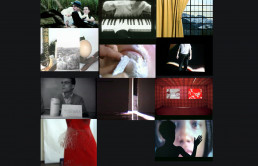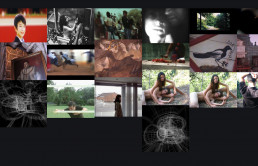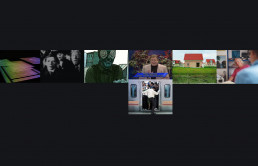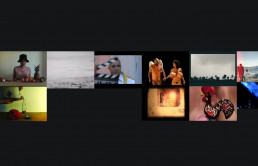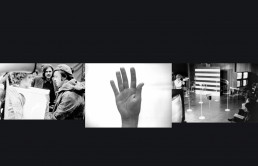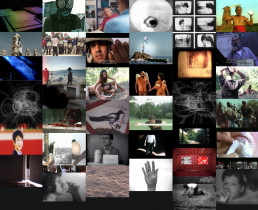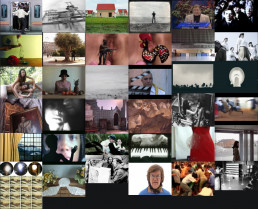FUSO 2010 – Programação
28 Julho, 19h
Inauguração BES Arte & Finança
VIDEOKUNST Record > Again!
40 Jahre Videokunst.de
A Vídeo Arte Alemã
Patente ao público até 31 Agosto
Duração total da projeção (loop contínuo) 59’30’’
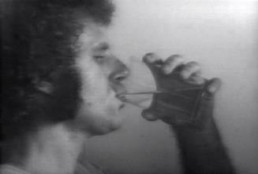
Klaus Rinke, Inhalation (Inalação), Alemanha, 1971, 3’43’’
Na década de 70 a água e os corpos são os elementos centrais na obra de Klaus Rinke. Nessa linha, produz um vídeo numa piscina com Gerry Schum, em 1971.
Na primeira parte de Inhalation, vemos Rinke, de cima, enquanto ele repetidamente respira fundo, mergulha na água, prende a respiração e volta à superfície no último momento. Isto é repetido 18 vezes à medida que os mergulhos se tornam mais curtos e o artista está cada vez mais exausto, até que nada para fora da pista. A segunda parte mostra uma reversão. Vemos a cabeça Rinke de perfil, ele pega um copo de água e bebe um litro de uma só vez. O elemento do perigo torna-se vital para a vida.
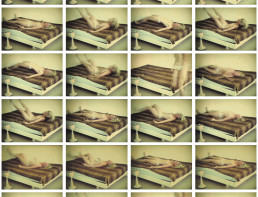
Heike Mutter, Ekstase 1 (Êxtase 1), Alemanha, 1998, 7’
Ekstase 1 trata da exploração do corpo humano num peculiar momento de tensão íntima. Uma mulher em roupa interior parece ter sido atirada para uma cama sintética de pele de leopardo. Está deitada imóvel até que os seus dedos começam subitamente a contrair-se. As contrações aumentam, invadindo todo o corpo. Quando o êxtase atingiu o clímax, o corpo agitado aquieta-se de novo, ficando imóvel mais uma vez.
Num loop infinito, o vídeo aponta criticamente para o modo como os nossos corpos estão disciplinados e, com isso, para os discursos de poder marcados pelos media.
C. O. Paeffgen, Erst das Hemd, dann die Kunst (Primeiro a Camisa, Depois a Arte), Alemanha, 1975, 9’59’’
Primeiro a Camisa, Depois a Arte é parte de ‘Umwicklungen’ (‘Embrulhos’), um grupo de trabalhos que primeiramente voltou a atenção do público para o artista. O material de base para este vídeo é uma t-shirt, que o artista previamente despiu. Com fio enrolado a toda a volta, torna-se na escultura que será montada na parede. O espectador pode assistir a esta metamorfose, à promoção de um objeto a obra de arte – em tempo real. No entanto, no final, o processo de produção é invertido: a t-shirt escultura é retirada da parede, desembrulhada, e novamente vestida.
O conceito de ready-made de Duchamp é congenialmente estendido no trabalho de C. O. Paeffgen.
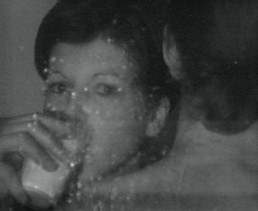
Ulrike Rosenbach & Klaus vom Bruch
Good Luck for a Better Art (Boa Sorte Para uma Melhor Arte), Alemanha, 1977, 5’12’’
Ulrike Rosenbach cospe leite por cima do ombro de Klaus vom Bruch e contra uma travessa de vidro. Cada vez que ela cospe, Klaus vom Bruch sussura: “Good luck for a better art!” A peça é marcada por uma certa monotonia. Muito pouco acontece, à parte da travessa de vidro ir ficando cada vez mais manchada de leite.
Em 1977, ano em que este vídeo foi produzido, vídeo e performance art estavam a marcar o fim da sua primeira década. Muitas experiências corporais e investigações críticas dos media pareciam já ter sido feitas. Nesse contexto, a mensagem “Good luck for a better art”, que é cantada alto e em coro uma vez mais depois de ela terminar de cuspir, toma um significado bastante sério.
Ursula Wevers, Horizontales/Vertikales Springen (Saltos Horizontais/Verticais), Alemanha, 1979, 12’29’’
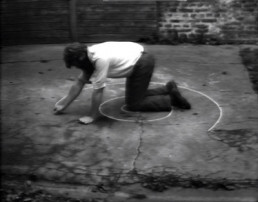
Ulrich Rückriem, Teilungen/Kreise/Diagonalen (1.Divisões, 2.Círculos, 3.Diagonais), Alemanha, 1971, 20’40’’
Os vídeos 1.Divisões, 2.Círculos, 3.Diagonais, foram produzidos por Ulrich Rückriem em 1970/1971 em cooperação com Gerry Schum e Ursula Wevers. O título lacónico aponta, desde logo, para a estética de renúncia neles concretizada: as elaborações de possibilidades para a criação da imagem são conscientemente evitadas. Num sentido inverso a escolha dos fundos frente aos quais o artista se concentra em mostrar, através da apresentação de ações simples, como consegue desenhar círculos e diagonais e partir ripas de madeira com a ajuda do corpo, é perspetivada com simplicidade deliberada na montagem das imagens. O declarado objetivo de Rückriem é dirigir conscientemente a atenção para o processo de produção por si só.
FUSO 2010 – Program July 28 – 31
July 28th, 7pm
Openning BES Arte & Finança
VIDEOKUNST Record > Again!
40 Jahre Videokunst.de
Open to the public until August 31st
Total running time (continuous loop) 59’30’’

Klaus Rinke, Inhalation, Germany, 1971, 3’43’’
In the 1970’s, water and bodies are the central elements in Klaus Rinke’s work. He, therefore, stays in that vein to also produce a video tape in a swimming bath together with Gerry Schum in 1971. We see Rinke from above as he repeatedly takes deep breaths, dives down into the water, holds his breath and surfaces at the last moment. This is repeated 18 times as the dives become shorter and shorter and the artist more and more exhausted until he swims out of the lane. That closes the first part of Inhalation.
The second part shows a reversal. We see Rinke’s head in profile; he takes up a glass of water and drinks a liter at once. The dangerous element has become one vital to life.

Heike Mutter, Ekstase 1, Germany, 1998, 7’
Ecstasy 1 is about exploring the human body at a peculiar moment of intimate tension. A woman clad only in briefs appears to have been thrown onto a synthetic bed covered with leopard skin. She lies motionless until her fingers suddenly start to twitch. The twitching increases, taking over her entire body. When her ecstasy has reached its climax, the tormented body settles down again, remaining still once more.
In an infinite loop the video engages critically with the way our bodies are disciplined and with that the discourses of power inscribed by the media.
C.O. Paeffgen, Erst das Hemd, dann die Kunst (The shirt first, Art second), Germany, 1975, 9’59’’
The Shirt first, Art second is part of Umwicklungen (wrappings) – a group of works which first brought the artist to the attention of the public. A t-shirt, which the artist himself had previously taken off, makes the raw material for this video. With wire wrapped all around it, it becomes a sculpture which is then mounted on a wall. The viewer can witness this metamorphosis – the upgrading of a mundane object to a work of art – in real time. In the end, however, the production process is reversed: The t-shirt sculpture is taken down from the wall, the object unwrapped and put on again.
Duchamp’s concept of the readymade is congenially extended in Paeffgen’s work.

Ulrike Rosenbach & Klaus vom Bruch, Good Luck for a Better Art, Germany, 1977, 5’12’’
Ulrike Rosenbach spits milk over Klaus vom Bruch’s shoulder and against a pane of glass. And every time she spits, Klaus vom Bruch whispers: “Good luck for a better art!” The piece possesses a certain monotony. Very little happens, apart from the pane of glass becoming milkier every time she spits.
In 1977, when this video was produced, video and performance art too were reaching the end of their first decade. Many bodily experiences and media-critical investigations seemed already to have been made. So the message in Good Luck for a better Art, which is sung loudly in chorus one last time after she has finished spitting, is meant quite seriously.
Ursula Wevers, Horizontales/Vertikales Springen (Leaping horizontally and vertically), Germany, 1979, 12’29’’
Ursula Wevers’ 1979 video, Horizontales/Vertikales Springen (Leaping horizontally and vertically) conjures up memories of your own sports classes or of afternoons on the playing field: you can see a person from the hips downwards, who is jumping on a trampoline. Now horizontally, now vertically, they appear rhythmically in the image-field, which materializes from two monitors set up alongside each other. At the same time, the video images ideally correspond to the notion of the white cube, as the performance happens in a sterile white space.
The video not only tests out categories like surface/space and image/sculpture, but also advocates new strategies of putting art across and of presenting it.

Ulrich Rückriem, Teilungen/Kreise/Diagonalen (1.Divisions, 2.Circles, 3.Diagonals), Germany, 1971, 20’40’’
The videos 1.Divisions, 2.Circles, 3.Diagonals, were produced by Ulrich Rückriem in 1970/1971 in cooperation with Gerry Schum and Ursula Wevers. The laconic titles already point to the aesthetic of renunciation realized in them: elaborate possibilities for image creation are consciously avoided. On the contrary – the choice of the backgrounds, before which the artist focuses on displaying through simple actions how he can draw circles and diagonals and break wooden laths with the help of his body, is angled at a deliberate simplicity in mounting images. Rückriem’s declared goal is to direct attention consciously onto the production process in that way.
